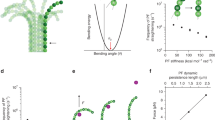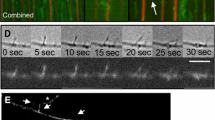Abstract
The process of neurite outgrowth is critically dependent on proper microtubule assembly. However, characterizing the dynamics of microtubule assembly and their quantitative relationship to neurite outgrowth is a difficult task. The difficulty can be reduced by using time series analysis which has broad application in characterizing the dynamics of stochastic, or “noisy,” behaviors. Here we apply time series analysis to quantitatively compare simulated microtubule assembly and neurite outgrowth in vitro. Microtubule length life histories were simulated assuming constant growth and shrinkage rates coupled with random selection of growth and shrinkage times, a formulation based on the dynamic instability model of microtubules assembly. Net length displacements of simulated microtubules were calculated at discrete, evenly spaced times, and the resulting time series were characterized by both spectral and autocorrelation analysis. Depending on the sampling rate and the dynamic parameters, simulated microtubules exhibited significant autocorrelation and periodicity. To make a comparison to neurite outgrowth, we characterized the dynamic behavior of simulated microtubule populations and found it was not significantly different from that of single microtubules. The net displacements of rat superior cervical ganglion neurite tips were measured and characterized using time series methods. Their behavior was consistent with the microtubule dynamics for appropriate simulation parameters and sampling rates. Our results show that time series analysis can provide a useful tool for quantitative characterization of microtubule dynamics and neurite outgrowth and for assessing the relationship between them.
Similar content being viewed by others
References
Alberts, B., D. Bray, J. Lewis, M. Raff, K. Roberts, and J. D. Watson. Molecular Biology of the Cell (3rd ed.). New York: Garland Publishing, 1994, 1294 pp.
Baas, P. W., and F. J. Ahmad. The transport properties of axonal microtubules establish their polarity orientation.J. Cell Biol. 120:1427–1437, 1993.
Bamburg, J. R., D. Bray, and K. Chapman. Assembly of microtubules at the tip of growing axons.Nature 321:788–790, 1986.
Bayley, P. M., M. J. Schilstra, and S. R. Martin. A simple formulation of microtubule dynamics: quantitative implications of the dynamic instability of microtubule populationsin vivo andin vitro.J. Cell Sci. 93:241–254, 1989.
Bayley, P. M., M. J. Schilstra, and S. R. Martin. Microtubule dynamic instability: Numerical simulation of microtubule transition properties using a Lateral Cap model.J. Cell Sci. 95:33–48, 1990.
Belmont, L. D., A. A. Hyman, K. E. Swain, and T. J. Mitchison. Real-time visualization of cell cycle-dependent changes in microtubule dynamics in cytoplasmic extracts.Cell 62:579–589, 1990.
Bloomfield, P. Fourier Analysis of Time Series: An Introduction. New York: John Wiley & Sons, 1976, 258 pp.
Brown, A., T. Slaughter, and M. M. Black. Newly assembled microtubules are concentrated in the proximal and distal regions of growing axons.J. Cell Biol. 119:867–882, 1992.
Buettner, H. M., R. Pittman, and J. Ivins. A model of neurite extension across regions of nonpermissive substrate: Simulations based on experimental measurement of growth cone motility and filopodia dynamics.Dev. Biol. 163:407–422, 1994.
Cassimeris, L., N. K. Pryer, and E. D. Salmon. Real-time observations of microtubule dynamic instability in living cells.J. Cell Biol. 107:2223–2231, 1988.
Chen, Y., and T. L. Hill. Use of Monte Carlo calculations in the study of microtubule subunit kinetics.Proc. Natl. Acad. Sci. USA 80:7520–7523, 1983.
Chen, Y., and T. L. Hill. Monte Carlo study of the GTP cap in a five-start helix model of a microtubule.Proc. Natl. Acad. Sci. USA 82:1131–1135, 1985.
Dogterom, M., and S. Leibler. Physical aspects of the growth and regulation of microtubule structures.Phys. Rev. Lett. 70:1347–1350, 1993.
Dunn, G. A., and A. F. Brown. A unified approach to analyzing cell motility.J. Cell Sci. Suppl. 8:81–102, 1987.
Durbin, J. The fitting of time-series models.Intl. Stat. Rev. 28:233–244, 1960.
Gildersleeve, R. F., A. R. Cross, K. E. Cullen, A. P. Fagen, and R. C. Williams Jr. Microtubules grow and shorten at intrinsically variable rates.J. Biol. Chem. 267: 7995–8006, 1992.
Gliksman, N. R., S. F. Parsons, and E. D. Salmon. Okadaic acid induces interphase to mitotic-like microtubule dynamic instability by inactivating rescue.J. Cell Biol. 119: 1271–1276, 1992.
Gliksman, N. R., E. D. Salmon, and R. A. Walker. Relating the kinetic parameters of dynamic instability to the cell: a computer simulation approach.J. Cell Biol. 105:30a, 1987.
Gliksman, N. R., R. V. Skibbens, and E. D. Salmon. How the transition frequencies of microtubule dynamic instability (nucleation, catastrophe, and rescue) regulate microtubule dynamics in interphase and mitosis: analysis using a Monte Carlo computer simulation.Mol. Biol. Cell 4:1035–1050, 1993.
Goldberg, D. J., and D. W. Burmeister. Stages in axon formation: observations of growth ofAplysia axons in culture using video-enhanced contrast-differential interference contrast microscopy.J. Cell Biol. 103:1921–1931, 1986.
Goldberg, D. J., and D. W. Burmeister. Looking into growth cones.Trends Neurosci. 12:503–506, 1988.
Heidemann, S. R., and J. R. McIntosh. Visualization of the structural polarity of microtubules.Nature 286:517–519, 1980.
Hill, T. L. Introductory analysis of the GTP-cap phase-change kinetics at the end of a microtubule.Proc. Natl. Acad. Sci. USA 81:6728–6732, 1984.
Hill, T. L. Linear Aggregation Theory in Cell Biology. New York: Springer-Verlag, 1987, 305 pp.
Hill, T. L., and Y. Chen. Phase changes at the end of a microtubule with a GTP gap.Proc. Natl. Acad. Sci. USA 81:5772–5776, 1984.
Hoffman, P. N., and R. J. Lasek. The slow component of axonal transport: Identification of major structural polypeptides of the axon and their generality among mammalian neurons.J. Cell Biol. 66:351–366, 1975.
Horio, T., and H. Hotani. Visualization of the dynamic instability of individual microtubules.Nature 321:605–607, 1986.
Katz, M. J., E. B. George, and L. J. Gilbert. Axonal elongation as a stochastic walk.Cell Motil. 4:351–370, 1984.
Marsh, L., and P. C. Letourneau. Growth of neurites without filopodial or lamellipodial activity in the presence of cytochalasin B.J. Cell Biol. 99:2041–2047, 1984.
Martin, S. R., M. J. Schilstra, and P. M. Bayley. Dynamic instability of microtubules: Monte Carlo simulation and application to different types of microtubule lattice.Biophys. J. 65:578–596, 1993.
Mitchison, T. J., and M. W. Kirschner. Dynamic instability of microtubule growth.Nature 312:237–242, 1984.
Mitchison, T. J., and M. W. Kirschner. Some thoughts on the partitioning of tubulin between monomer and polymer under conditions of dynamic instability.Cell Biophys. 11: 35–55, 1987.
O'Brien, E. T., E. D. Salmon, R. A. Walker, and H. P. Erickson. Effects of magnesium on the dynamic instability of individual microtubules.Biochemistry 29:6648–6656, 1990.
Okabe, S., and N. Hirokawa. Microtubule dynamics in nerve cells: analysis using microinjection of biotinylated tubulin into PC12 cells.J. Cell Biol. 107:651–664, 1988.
Okabe, S., and N. Hirokawa. Do photobleached fluorescent microtubules move?: Re-revaluation of fluorescence laser photobleaching bothin vitro and in growingXenopus axon.J. Cell Biol. 120:1177–1186, 1993.
Olkin, I., L. J. Gleser, and C. Derman. Probability Models and Applications. New York: Macmillan Publishing Co., Inc., 1980, 576 pp.
Partin, A. W., J. S. Schoeniger, J. L. Mohler, and D. S. Coffey. Fourier analysis of cell motility: Correlation of motility with metastatic potential.Proc. Natl. Acad. Sci. USA 86:1254–1258, 1989.
Press, W. H., S. A. Teukolsky, W. T. Vetterling, and B. P. Flannery. Numerical Recipes in Fortran (2nd ed.). New York: Press Syndicate of the University of Cambridge, 1992, 963 pp.
Pryer, N. K., R. A. Walker, V. P. Skeen, B. D. Bourns, M. F. Sobeiro, and E. D. Salmon. Brain microtubule-associated proteins modulate microtubule dynamic instabilityin vitro.J. Cell Sci. 103:965–976, 1992.
Reinsch, S. S., T. J. Mitchison, and M. W. Kirschner. Microtubule polymer assembly and transport during axonal elongation.J. Cell Biol. 115:365–379, 1991.
Sammak, P. J., and G. G. Borisy. Direct observation of microtubule dynamics in living cells.Nature 332:724–726, 1988.
Schilstra, M. J., P. M. Bayley, and S. R. Martin. The effect of solution composition on microtubule dynamic instability.Biochem. J. 277:839–847, 1991.
Schulze, E., and M. Kirschner. New features of microtubule behaviour observedin vivo.Nature 334:356–359, 1988.
Shelden, E., and P. Wadsworth. Observation and quantification of individual microtubule behaviorin vivo: microtubule dynamics are cell-type specific.J. Cell Biol. 120:935–945, 1993.
Simon, J. R., S. F. Parsons, and E. D. Salmon. Buffer conditions and non-tubulin factors critically affect the microtubule dynamic instability of sea urchin egg tubulin.Cell Motil. Cytoskel. 21:1–14, 1992.
Tanaka, E. M., and M. W. Kirschner. Microtubule behavior in the growth cones of living neurons during axon elongation.J. Cell Biol. 115:345–363, 1991.
Verde, F., M. Dogterom, E. Stelzer, E. Karsenti, and S. Leibler. Control of microtubule dynamics and length by cyclin A- and cyclin B-dependent kinases inXenopus egg extracts.J. Cell Biol. 118:1097–1108, 1992.
Walker, R. A., E. T. O'Brien, N. K. Pryer, M. F. Soboeiro, W. A. Voter, H. P. Erickson, and E. D. Salmon. Dynamic instability of individual microtubules analyzed by video light microscopy: rate constants and transition frequencies.J. Cell Biol. 107:1437–1448, 1988.
Wei, W. W. S. Time Series Analysis: Univariate and Multivariate Methods. Reading, MA: Addison-Wesley, 1990. 478 pp.
Yu, W., V. E. Centonze, F. J. Ahmad, and P. W. Baas. Microtubule nucleation and release from the neuronal centrosome.J. Cell Biol. 122:349–359, 1993.
Author information
Authors and Affiliations
Rights and permissions
About this article
Cite this article
Odde, D.J., Buettner, H.M. Time series characterization of simulated microtubule dynamics in the nerve growth cone. Ann Biomed Eng 23, 268–286 (1995). https://doi.org/10.1007/BF02584428
Received:
Revised:
Accepted:
Issue Date:
DOI: https://doi.org/10.1007/BF02584428




